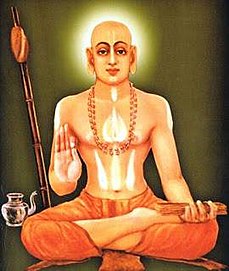Sumatindra Tirtha
Sumatindra Tirtha (c. 1692 – c. 1725) was a Dvaita scholar and the 20th pontiff of the Madhva matha at Kumbakonam (also known as Raghavendra Matha). Succeeding Surindra Tirtha in 1692, Sumatindra extended the reach of the matha from Kumbakonam to Thanjavur, Madurai and Srirangam. Through his travels and a close association with the royalty, Sumatindra was able to proliferate the principles of Dvaita in the Tamil region. [1] An accomplished scholar and poet, he has authored numerous works on poetics, drama and music as well as commentaries on Vedanta.
Sumatindra Tirtha | |
|---|---|
 The tomb or Brindavana of Sumatindra Tirtha in Srirangam | |
| Personal | |
| Religion | Hinduism |
| Order | Vedanta |
| Philosophy | Dvaita |
| Religious career | |
| Guru | Venkatanarayana, Surindra Tirtha |
Disciples
| |
| Literary works | Bhavaratnakosha, Usha Harna Bhashya, Jayaghoshana |
| Part of a series on |
| Dvaita |
|---|
 |
|
Literature
|
|
|
Holy places |
| Hinduism portal |
Life
Born as Muddu Krishnacharya, he seems to have studied tarka (Logic), vyakarana (grammar) and mimamsa (scriptural injunctions) under the guidance of Raghavendra [2] though he considers his father, Venkatanarayana, as his teacher.[3] His two brothers Yogindra and Surindra served as pontiffs of the matha before him. He took on the name of Sumatindra after his initiation into sannyasa. Through his travels in the present day Karnataka and Telangana, he engaged in debates and discussions with Advaita and Dvaita scholars alike. [2] He maintained cordial relationship with the Madurai Nayaks and the Thanjavur Marathas as evidenced by grants made in his name. Queen Mangamma of Madurai granted him the hamlet of Ayirdharma and lands in the town of Srirangam where he built his matha. [4] Under his aegis, the matha also received a part of the tithes from Payaranipalyam and other neighboring villages. [4] His panegyric on the Thanjavur ruler Sahaji I indicates familiarity with the ruler.[3] Succeeded by Upendra Tirtha, he is entombed in Srirangam.
Works
Sumatindra's works span a wide range of subjects, from alankara (poetics) to vedanta. He has authored commentaries on the works of Jayatirtha and Vyasatirtha, while quoting from a variety of sources including Puranas and obscure works from pontiffs of the yore, Padmanabha and Narahari. In the realm of poetics, he has authored a commentary on the works of Sudhindra Tirtha and Trivikrama Pandita, an early disciple of Madhva. His Shahavilasa is a treatise on music while his Abhinavakadambari is a poetic work. [5]
Works on the Brahmasutra
| Name | Description | References |
|---|---|---|
| Bhavaratnakosha | Commentary on Gita Bhashya Prameyadipika of Jayatirtha | [6] |
| Rg Bhashya | A non-extant commentary on Rg Bhashya of Jayatirtha | [7] |
| Vakyarathnakosha | Commentary on Nyaya Sudha of Jayatirtha | [7] |
| Adhikaranaratnamala | Summary of the Brahma Sutra | [7] |
| Tantrasara Bhashya | Commentary on Tantrasara of Madhva | [7] |
| Tattvaprakashika Bhashya | Commentary on Tattvaprakashika of Jayatirtha | [7] |
Works on the Alamkara and Kavya
| Name | Description | References |
|---|---|---|
| Madhudhara | Commentary on Alamkara Manjari of Sudhindra Tirtha | [8] |
| Rasikaranjini | Commentary on Ushaharana of Trivikrama Pandita | [9] |
| Vyasaraja Vijaya Bhashya | Commentary on Vyasaraja Vijaya of Vijayindra | [10] |
| Subhadra Parinaya Bhashya | Annotations on the drama Subhadra Parinaya by Vijayindra | [10] |
| Yogindra Vijaya | Panegyric on his predecessor, Yogindra Tirtha | [10] |
| Shahavilasa | Treatise on music | [5] |
| Abhinavakadambari | A poetic work | [5] |
| Jayaghoshana | Panegyric on Sahaji I | [3] |
Short metrical verse
| Name | Description | References |
|---|---|---|
| Yogindra Taravali | A metrical work recounting the deeds of Yogindra Tirtha | [7] |
| Rama Taravali | A metrical work praising the life and deeds of Rama | [7] |
| Ramadandaka | Verse in praise of the tutelary deity of the Kumbakonam matha | [7] |
| Narasimha Stuti | Verse in praise of Narasimha | [7] |
References
- Sarma 1945.
- Sharma 2000, p. 505.
- Sastri 1929, p. 2695.
- Devadevan 2016, p. 136.
- Krishnamachariar 1939, p. 245.
- Pandurangi 1963, p. 184.
- Sharma 2000, p. 506.
- Sriramamurti 1972, p. 169.
- Sastri 1929, p. 2691.
- Sharma 2000, p. 507.
Bibliography
- Sharma, B.N.K (2000) [1961]. History of Dvaita school of Vedanta and its Literature (3rd ed.). Bombay: Motilal Banarasidass. ISBN 81-208-1575-0.CS1 maint: ref=harv (link)
- Sarma, Nagaraj (1945). Bheda Vidya Vilasa. Nanjangud: Sri Parimala Publishing House.CS1 maint: ref=harv (link)
- Sriramamurti, P. (1972). Contribution of Andhra to Sanskrit Literature. Andhra University.CS1 maint: ref=harv (link)
- Pandurangi, K.T (1963). A Descriptive Catalogue of Sanskrit Manuscripts.CS1 maint: ref=harv (link)
- Sastri, P.P.S (1929). A Descriptive Catalogue of Sanskrit Manuscripts of the Government Oriental Manuscripts Library.CS1 maint: ref=harv (link)
- Devadevan, Manu (2016). A Prehistory of Hinduism. Walter de Gruyter GmbH & Co KG.CS1 maint: ref=harv (link)
- Krishnamachariar, M (1939). History of Classical Sanskrit Literature. Tirupati-Tirumala Devasthanam Press.CS1 maint: ref=harv (link)